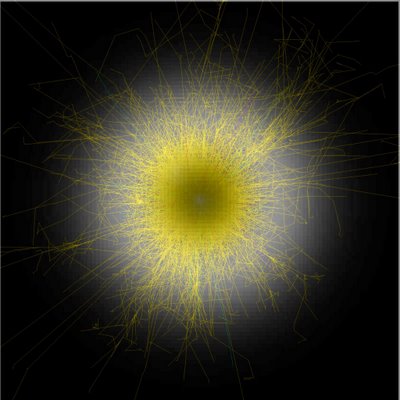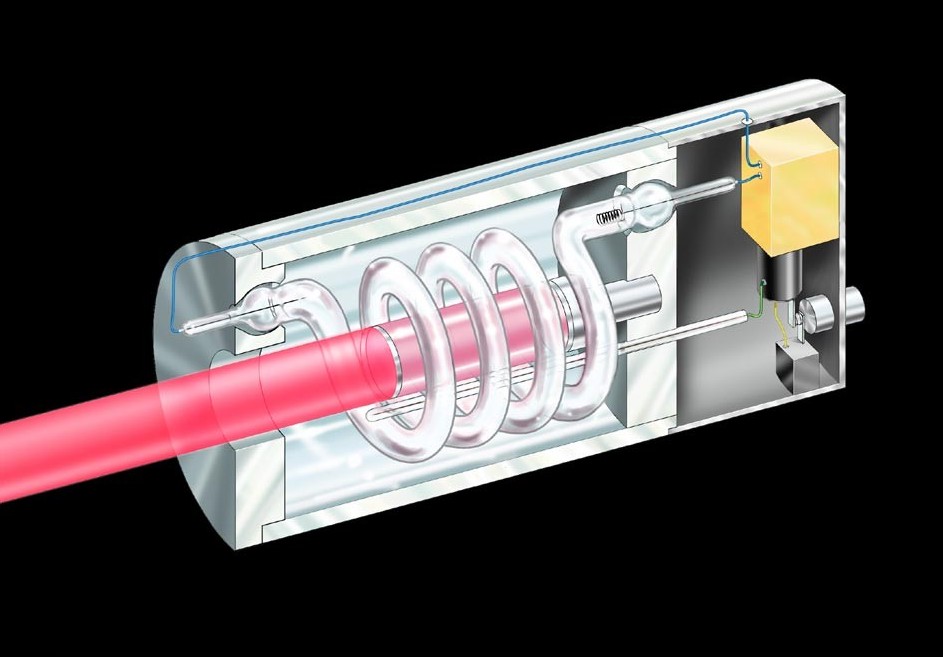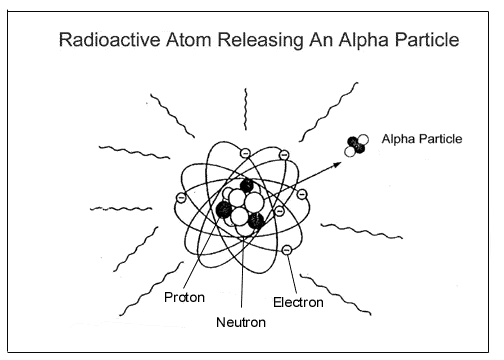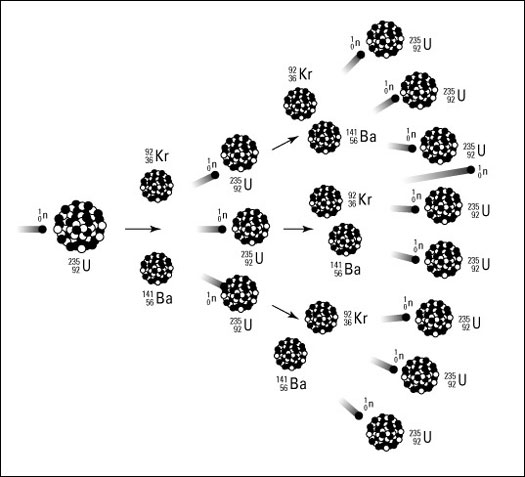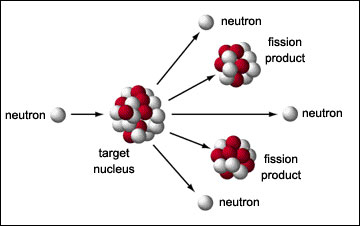Atoms And Nuclei Quiz

This quiz is multiple choice which tests the participants’ conceptual knowledge about the topic 'Atoms and Nuclei'. The questions involve knowledge from four main sections including; The Structure of the Atom, The Structure of the Nucleus, Radioactivity and Nucleur Fission and Fusion.
- 1.
Planck's constant has a value of
- A.
6.626 × 10^-34
- B.
1.055 × 10^34
- C.
8.988 × 10^-16
- D.
8.85 × 10^26
Correct Answer
A. 6.626 × 10^-34Explanation
Planck's constant is a fundamental constant in quantum mechanics that relates the energy of a photon to its frequency. It is denoted by the symbol "h" and has a value of 6.626 × 10^-34 J·s. This means that the energy of a photon is equal to the product of Planck's constant and the frequency of the photon. The given answer, 6.626 × 10^-34, is the correct value for Planck's constant.Rate this question:
-
- 2.
A photon is a particle that
- A.
Cannot travel in a vacuum.
- B.
Has zero electric charge.
- C.
Has zero electric field associated with it.
- D.
Has a velocity in a vacuum that varies with the photon frequency.
Correct Answer
B. Has zero electric charge.Explanation
A photon is a particle of light that carries energy and has properties of both particles and waves. It does not have any electric charge, which means it is not affected by electric fields or magnetic fields. This is why photons can travel freely in a vacuum, as they are not influenced by any electromagnetic forces.Rate this question:
-
- 3.
What is the ionization energy of the neutral hydrogen atom?
- A.
6.8 eV
- B.
13.6 eV
- C.
27.2 eV
- D.
None of the given answers
Correct Answer
B. 13.6 eVExplanation
The ionization energy of the neutral hydrogen atom is 13.6 eV. Ionization energy is the amount of energy required to remove an electron from an atom or ion in its ground state. In the case of hydrogen, it takes 13.6 eV of energy to remove an electron from a neutral hydrogen atom, resulting in the formation of a hydrogen ion. This value is a well-known and experimentally determined quantity in atomic physics.Rate this question:
-
- 4.
The wavelength of a ruby laser is 694.3 nm. What is the energy difference between the two energy states involved in laseraction?
- A.
1.812 eV
- B.
1.646 eV
- C.
1.537 eV
- D.
1.786 eV
Correct Answer
D. 1.786 eVExplanation
The energy difference between two energy states can be calculated using the formula E = hc/λ, where E is the energy difference, h is Planck's constant, c is the speed of light, and λ is the wavelength. Plugging in the values, we get E = (6.626 x 10^-34 J s)(3 x 10^8 m/s)/(694.3 x 10^-9 m) = 2.853 x 10^-19 J. To convert this to electron volts (eV), we divide by the charge of an electron (1.602 x 10^-19 C), giving us 1.786 eV.Rate this question:
-
- 5.
An atom's atomic number is determined by the number of
- A.
Neutrons in its nucleus.
- B.
Alpha particles in its nucleus.
- C.
Protons in its nucleus.
- D.
Nucleons in its nucleus.
Correct Answer
C. Protons in its nucleus.Explanation
An atom's atomic number is determined by the number of protons in its nucleus. The atomic number represents the number of protons in an atom, which defines its identity as a particular element. Neutrons and alpha particles do not contribute to the atomic number, while nucleons is a general term that includes both protons and neutrons. Therefore, the correct answer is protons in its nucleus.Rate this question:
-
- 6.
If an atom's atomic number is given by Z, its atomic mass by A, and its neutron number by N, which of the following is correct?
- A.
N = Z - A
- B.
N = A - Z
- C.
N = A + Z
- D.
None of the given answers
Correct Answer
B. N = A - ZExplanation
The neutron number (N) of an atom can be calculated by subtracting the atomic number (Z) from the atomic mass (A). Therefore, the correct answer is N = A - Z.Rate this question:
-
- 7.
There is a limit to the size of a stable nucleus because of
- A.
The limited range of the strong nuclear force.
- B.
The weakness of the gravitational force.
- C.
The weakness of the electrostatic force.
- D.
None of the given answers
Correct Answer
A. The limited range of the strong nuclear force.Explanation
The correct answer is "the limited range of the strong nuclear force." The strong nuclear force is responsible for holding the protons and neutrons together in the nucleus of an atom. However, this force has a limited range, meaning it only acts over a short distance. As the number of protons and neutrons in a nucleus increases, the distance between them also increases. Eventually, the strong nuclear force becomes too weak to overcome the electrostatic repulsion between the positively charged protons. This leads to instability in the nucleus and the formation of a more stable nucleus through processes like radioactive decay.Rate this question:
-
- 8.
When nucleons join to form a stable nucleus, energy is
- A.
Absorbed.
- B.
Not transferred.
- C.
Destroyed.
- D.
Released.
Correct Answer
D. Released.Explanation
When nucleons join to form a stable nucleus, energy is released. This is because the process of nuclear fusion, where nucleons combine to form a larger nucleus, results in a decrease in the total mass of the system. According to Einstein's mass-energy equivalence principle (E=mc²), this decrease in mass is converted into energy. Therefore, when nucleons come together to form a stable nucleus, the excess energy is released in the form of radiation or other forms of energy.Rate this question:
-
- 9.
The binding energy per nucleon
- A.
Decreases steadily as we go to heavier elements.
- B.
Has a maximum near iron in the periodic table.
- C.
Is approximately constant throughout the periodic table, except for very light nuclei.
- D.
Increases steadily as we go to heavier elements.
Correct Answer
B. Has a maximum near iron in the periodic table.Explanation
The binding energy per nucleon refers to the amount of energy required to remove a nucleon from an atomic nucleus. As we go to heavier elements, the binding energy per nucleon decreases steadily. However, near iron in the periodic table, there is a peak in the binding energy per nucleon. This is because iron has a particularly stable nucleus, with a balance between the attractive nuclear force and the repulsive electromagnetic force. As we move away from iron in either direction, the binding energy per nucleon decreases again.Rate this question:
-
- 10.
An alpha particle will be attracted to a
- A.
Proton.
- B.
Gamma ray.
- C.
Positive charge.
- D.
Negative charge.
Correct Answer
D. Negative charge.Explanation
An alpha particle is a positively charged particle consisting of two protons and two neutrons. According to the principles of electrostatics, opposite charges attract each other. Since the alpha particle is positively charged, it will be attracted to a negative charge. Therefore, the correct answer is negative charge.Rate this question:
-
- 11.
When a gamma ray is emitted from an unstable nucleus,
- A.
The number of neutrons drops by one and the number of protons increases by one.
- B.
There is no change in either the number of neutrons or the number of protons.
- C.
The number of neutrons and the number of protons drop by two.
- D.
None of the given answers
Correct Answer
B. There is no change in either the number of neutrons or the number of protons.Explanation
When a gamma ray is emitted from an unstable nucleus, it does not involve any changes in the number of protons or neutrons. Gamma rays are high-energy photons that are emitted to release excess energy from a nucleus, but they do not affect the composition or structure of the nucleus itself. Therefore, the number of neutrons and protons remains the same before and after the emission of a gamma ray.Rate this question:
-
- 12.
The atomic number and mass number for calcium 39 are 20 and 39, respectively. How many protons are in one atom?
- A.
20
- B.
39
- C.
1
- D.
19
Correct Answer
A. 20Explanation
The atomic number of an element represents the number of protons in the nucleus of an atom. In this case, the atomic number of calcium is 20, which means that there are 20 protons in one atom of calcium. Therefore, the correct answer is 20.Rate this question:
-
- 13.
If 4.0 × 1018 atoms decay with a half-life of 2.3 years, how many are remaining after 3.7 years?
- A.
1.1 ×1018
- B.
1.3 × 1018
- C.
2.5 × 1018
- D.
1.7 × 1018
Correct Answer
B. 1.3 × 1018Explanation
The question asks for the number of atoms remaining after 3.7 years, given that 4.0 × 1018 atoms decay with a half-life of 2.3 years. To solve this, we can use the formula for exponential decay: N(t) = N₀ * (1/2)^(t/h), where N(t) is the number of atoms remaining after time t, N₀ is the initial number of atoms, t is the time elapsed, and h is the half-life. Plugging in the values, we get N(3.7) = 4.0 × 1018 * (1/2)^(3.7/2.3) ≈ 1.3 × 1018. Therefore, the correct answer is 1.3 × 1018.Rate this question:
-
- 14.
In a nuclear reaction, what value is conserved in addition to electric charge, energy, and momentum?
- A.
Atomic number
- B.
Nucleon number
- C.
Neutron number
- D.
None of the given answers
Correct Answer
B. Nucleon numberExplanation
In a nuclear reaction, the nucleon number is conserved in addition to electric charge, energy, and momentum. The nucleon number refers to the total number of protons and neutrons in the nucleus of an atom. During a nuclear reaction, the total number of nucleons remains constant, meaning that neither protons nor neutrons are created or destroyed. This conservation law helps to explain the stability and balance of atomic nuclei during nuclear reactions.Rate this question:
-
- 15.
A nuclear reaction is said to be exothermic if the total kinetic energy is
- A.
Zero after the reaction.
- B.
Equal both before and after the reaction
- C.
Less after the reaction than before.
- D.
. greater after the reaction than before.
Correct Answer
D. . greater after the reaction than before.Explanation
An exothermic nuclear reaction releases energy, resulting in an increase in kinetic energy. Therefore, the total kinetic energy after the reaction is greater than before.Rate this question:
-
- 16.
The fuel for nuclear fission is
- A.
He.
- B.
U.
- C.
H.
- D.
Any radioactive material.
Correct Answer
B. U.Explanation
The correct answer is U, which stands for uranium. Uranium is the primary fuel used in nuclear fission reactions. It is a radioactive material that undergoes fission when bombarded with neutrons, releasing a large amount of energy. Other radioactive materials can also be used as fuel in nuclear fission reactions, but uranium is the most commonly used due to its abundance and favorable nuclear properties.Rate this question:
-
- 17.
What is the meaning of the term "critical mass"?
- A.
This refers to the minimum amount of fissionable material required to sustain a chain reaction.
- B.
This refers to the mass of the "critical" elements in a reactor, i.e., the uranium or plutonium.
- C.
This is the material which is just on the verge of becoming radioactive.
- D.
This is the amount of mass needed to make a power reactor economically feasible.
Correct Answer
A. This refers to the minimum amount of fissionable material required to sustain a chain reaction.Explanation
Critical mass refers to the minimum amount of fissionable material required to sustain a chain reaction. In nuclear reactions, a chain reaction occurs when the release of neutrons from one fission event triggers subsequent fission events. To maintain a self-sustaining reaction, there must be enough fissionable material present to produce a sufficient number of neutrons to sustain the chain reaction. If the amount of material is below the critical mass, the reaction will not be self-sustaining and will eventually die out. Therefore, critical mass is the minimum threshold required for a sustained chain reaction to occur.Rate this question:
-
- 18.
What is necessary to stop beta particles?
- A.
Metal foil
- B.
Air alone
- C.
Paper
- D.
Thick metal
Correct Answer
A. Metal foilExplanation
Metal foil is necessary to stop beta particles because it has a high density and atomic number, which allows it to effectively absorb and block the high-energy beta particles. The metal foil acts as a barrier, preventing the particles from passing through and causing any further damage or radiation exposure. Air alone and paper are not dense enough to stop beta particles, while thick metal may be excessive and not necessary for stopping them.Rate this question:
-
- 19.
The fission reaction 235U + 1n → 141Ba + 92Kr + neutrons, the number of neutrons produced is
- A.
1
- B.
Zero
- C.
3
- D.
2
Correct Answer
C. 3Explanation
In a fission reaction, 235U (uranium) absorbs a neutron (1n) and splits into two smaller nuclei, 141Ba (barium) and 92Kr (krypton), along with the release of three neutrons. Therefore, the number of neutrons produced in this reaction is 3.Rate this question:
-
- 20.
What is the energy released (positive) or absorbed (negative) in the following reaction? 3H (3.016049) + 3H (3.016049) = 4He (4.002603) + 2(1n) (1.008665)
- A.
0.0122 MeV
- B.
-11.3 MeV
- C.
-0.0122 MeV
- D.
11.3 MeV
Correct Answer
D. 11.3 MeVExplanation
The correct answer is 11.3 MeV. This is because the reaction involves the fusion of three hydrogen nuclei (protons) to form a helium nucleus and two neutrons. This fusion process releases energy, and the energy released is 11.3 MeV.Rate this question:
-
Quiz Review Timeline +
Our quizzes are rigorously reviewed, monitored and continuously updated by our expert board to maintain accuracy, relevance, and timeliness.
-
Current Version
-
Mar 22, 2023Quiz Edited by
ProProfs Editorial Team -
Oct 11, 2010Quiz Created by
Jsires11
- Acceleration Quizzes
- Acoustic Quizzes
- Chapters Of Physics Quizzes
- Distance Quizzes
- Electrolysis Quizzes
- Energy Quizzes
- ESD Quizzes
- Frequency Quizzes
- Light And Reflection Quizzes
- Logic Gate Quizzes
- Magnetic Field Quizzes
- Momentum Quizzes
- Motion Quizzes
- Online Physics Quizzes
- Optics Quizzes
- Physics Of Sound Quizzes
- Practice Physics Quizzes
- Properties Of Matter Quizzes
- Quantum Quizzes
- Quantum Physics Quizzes
- Reflection Quizzes
- Refraction Quizzes
- Secondary 3 Physics Quizzes
- Sound Quizzes
- Speed Of Light Quizzes
- Thermodynamics Quizzes
- Velocity Quizzes
- Work And Energy Quizzes
 Back to top
Back to top



